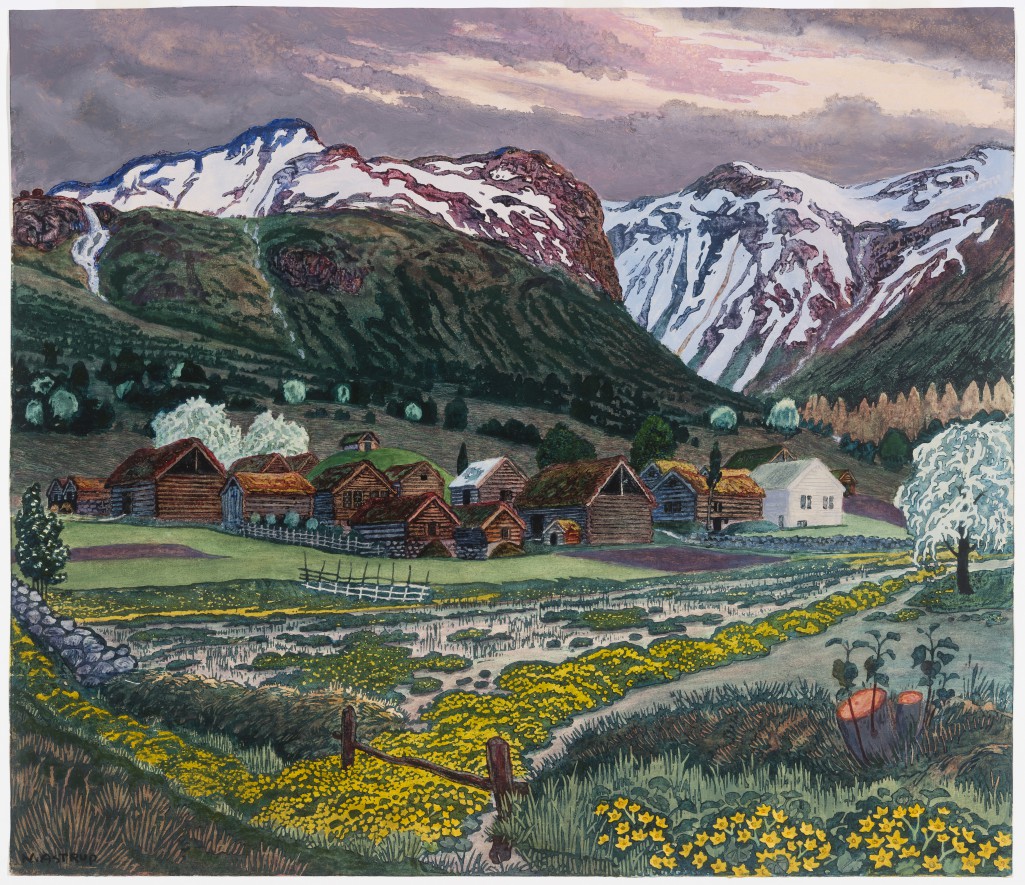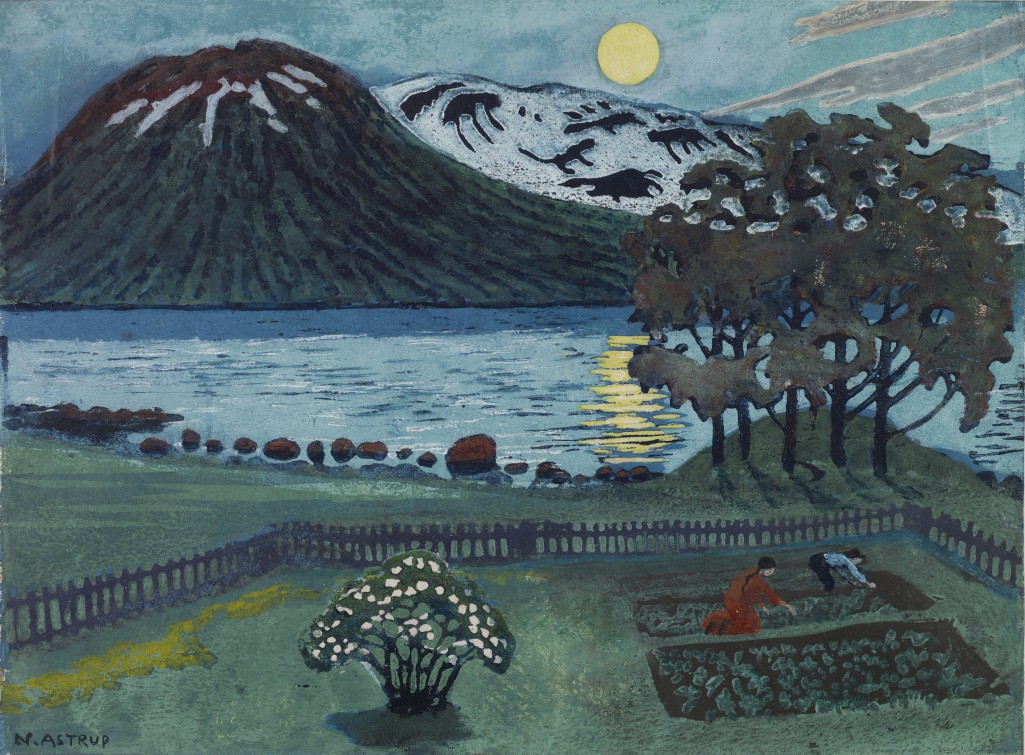The Norwegian artist Nikolai Astrup (1880–1928) liked making lists. In his neat ‘Miscellaneous Motifs I–III’ notebooks, he listed 325 ideas for paintings and woodcuts. These motifs included yellow marigolds against dark green marshland, and white mountains catching the glow of a sunlit night sky – images which capture the spirit of the western region of Jølster where Astrup lived and worked. His devotion to the region’s folklore and landscape has made him one of Norway’s best-loved artists. For the same reasons, he is comparatively unknown outside his homeland.
This is the first major exhibition of Astrup’s work in the UK. The Dulwich Picture Gallery is well known for resurrecting artists’ reputations, but why focus on an artist whose work is so specific to Norway? Isn’t it a bit like demanding we eat fermented fish at a dinner party, at which some tastes don’t translate? It takes time for the eye to adjust to Astrup’s naïve rural scenes and saturated colour palette: maidens sow seeds under May moons; couples dance around Midsummer bonfires. Nature is characterised as a mysterious force, full of magical potential. Yet Astrup’s works reveal something more unusual than trees that turn into trolls. The exhibition demonstrates the artist’s fierce independence; his retreat to Jølster was not a withdrawal, but a way of intensifying an acute awareness of his environment.
The exhibition, which includes 120 works, opens with paintings made at the family parsonage (his father was a pastor). Astrup’s work is frequently interwoven with references to his childhood, yet his upbringing was far from idyllic. His devoutly religious father had an ascetic attitude towards household heating, and Astrup developed asthma – the source of the tuberculosis which eventually killed him. Indeed, his preference for nocturnal painting was largely because he found it easier to breathe at night. The works on show here reveal an early awareness of how climatic conditions evoke a certain mood. Astrup often paints the same landscape under different skies, and is a master of depicting many types of rain: a palette of greys casts a heavy drizzle over The Parsonage in the Rain (before 1908); By the Open Door (before 1911) uses thick white highlights and a heightened perspective to suggest the brightness of sun after a storm.
As a student of Harriet Backer in Oslo and Christian Krohg in Paris, Astrup was primed to become part of the neo-romantic naturalist school which emerged in the wake of the Norwegian romantic painter Johan Christian Dahl. However, Astrup’s innovative spirit surpassed that of his teachers; Krohg confessed to feeling ‘embarrassed’ to be teaching a student of such vision. After being awarded a travel stipend in 1901, Astrup made study tours around Europe before returning to Jølster in 1902. In Paris he was liberated from naturalism by the work of Henri Rousseau and Maurice Denis, and later in London he learnt from the landscapes of J.M.W. Turner and John Constable. In 1911, his attendance at the XXII Berlin Secession exhibition exposed him to radical practices in Cubism, Fauvism, and German Expressionism.
Marsh Marigold Night (c. 1915), Nikolai Astrup. The Savings Bank Foundation DNB/The Astrup Collection/KODE Art Museums of Bergen

However, Astrup’s exposure to other artists prompted crises of confidence. How could he reconcile a love of the symbolism of Arnold Böcklin with the explosive abstraction of Wassily Kandinsky? How could his admiration for Norwegian painters such as Erik Werenskiold and Theodor Kittelsen compete with international modernism? Astrup lamented the use of illusory effects to impose a mood, blaming the Impressionists for their tendency to ‘dissolve, split and tamper’ with colour and light – he distrusted his contemporary Edvard Munch for the same reason. The Norwegian eye, he declared, saw ‘straight through the air and right onto the thing […] all colours appear intact as though they are near’.
For Astrup, that clarity of vision was best expressed at home in Norway, beside the Jølstravatnet lake. Arguably the most inventive works in the show are the woodcuts he made after settling at Sandalstrand, the smallholding he established with his wife Engel in 1912. Created by applying coloured oil paint to each individual woodblock and finished by brush, a series such as Marsh Marigold Night (c. 1915) are prints in which every sheet is original. The fact that Munch owned three of Astrup’s monochrome woodcuts suggests that he wasn’t quite attuned to how his fellow artist used colour to suggest subtle variations in mood.
Most of the works on display were coaxed from private collections, and the curators have chosen not to include the most cherished mythological pieces displayed in Norway’s national museums. Co-curator Ian Dejardin admits that, while technically impressive, works such as the fey Foxgloves (1920) are too saccharine for contemporary tastes. Importantly, the layout of the overall display offers multiple ways of reading the show. At the centre of the exhibition are two rooms dedicated to prints: turn left and you enter the dense atmosphere of the parsonage; turn right for the fevered Midsummer bonfires – some of Astrup’s most well-known works. Between these two extremes, the viewer is granted a new way of looking.
Nikolai Astrup: Painting Norway is at the Dulwich Picture Gallery, London, until 15 May
From the March issue of Apollo: preview and subscribe here.




